Paper Menu >>
Journal Menu >>
 Journal of Behavioral and Brain Science, 2011, 1, 153-159 doi:10.4236/jbbs.2011.13020 Published Online August 2011 (http://www.SciRP.org/journal/jbbs) Copyright © 2011 SciRes. JBBS Response Inhibition and Memory Retrieval of Emotional Target Words: Evidence from an Emotional Stop-Signal Task Cornelia Herbert1, Stefan Sütterlin1,2 1Department of Psycholo gy , University of Würzburg, Würzburg, Germany 2Integrative Research Unit on Social and Individual Development (INSIDE), University of Luxembourg, Luxembourg, Luxembourg E-mail: cornelia.herbert@psychologie.uni-wuerzburg.de Received April 9, 2011; revised May 4, 2011; accepted June 20, 201 1 Abstract Previous research suggests that emotional stimuli capture attention and guide behavior often automatically. The present study investigated the relationship between emotion-driven attention capture and motor response inhibition to emotional words in the stop-signal task. By experimental variations of the onset of motor re- sponse inhibition across the time-course of emotional word processing, we show that processing of emo- tional information significantly interferes with motor response inhibition in an early time-window, previ- ously related to automatic emotion-driven attention capture. Second, we found that stopping reduced mem- ory recall for unpleasant words during a subsequent surprise free recall task supporting assumptions of a link between mechanisms of motor response inhibition and memory functions. Together, our results provide be- havioral evidence for dual competition models of emotion and cognition. This study provides an important link between research focusing on different sub-processes of emotion processing (from perception to action and from action to memory). Keywords: Emotion, Response Inhibition, Memory, Motivated Attention 1. Introduction Response inhibition is an imp ortant key featur e of human behavioral control. Response inhibition includes both, inhibition of anticipated behavioral responses as well as stopping of already initiated behavioral responses to task-relevant stimuli. Regarding emotional stimuli, a wealth of studies suggest that emoti onal compared to ne u- tral stimuli capture attention and guide behavior auto- matically [1]. Emotional stimuli are associated with ap- proach and avoidance, i.e., action tendencies that pro- mote individual survival and well-being [1]. Responses to emotional stimuli should thus be generally harder to inhibit compared to neutral stimuli because of their sur- vival relevance. So far, a number of studies support this assumption. Behaviorally, findings converge on a gen- eral trend towards reduced performance when confronted with emotional relative to neutral stimuli in tasks that require response inhibition such as the go-nogo task [2-4]. The stop-signal task (SST) [5,6] represents a paradigm in which an already initiated response to task-relevant stimuli has to be inhibited as quickly as possible. The di- fficulty of response inhibition varies as a function of the temporal delay between the target stimulus and the stop- signal signaling the subject to stop his/her response. The outcome of this race between responding and stopping has recently been demonstrated to be modulated by the stimulus’ emotional significance [7]. Verbruggen and De Houwer [7] used emotional and neutral picture stimuli and the stop-signal task. Pictures were of highly arousing, unpleasant and pleasant content or of low arous- ing neutral content and presented 500 ms before the on- set of the target stimuli, which consisted of symbolic items (geometric shapes). Reaction times to targets in trials requiring no inhibition (go-trials) were sig nificantly longer for targets preceded by emotional compared to neutral pictures. In addition, processing of emotional com- pared to neutral pictures significantly increased stop-sig- nal reaction times (SSRT) to the neutral symbolic target 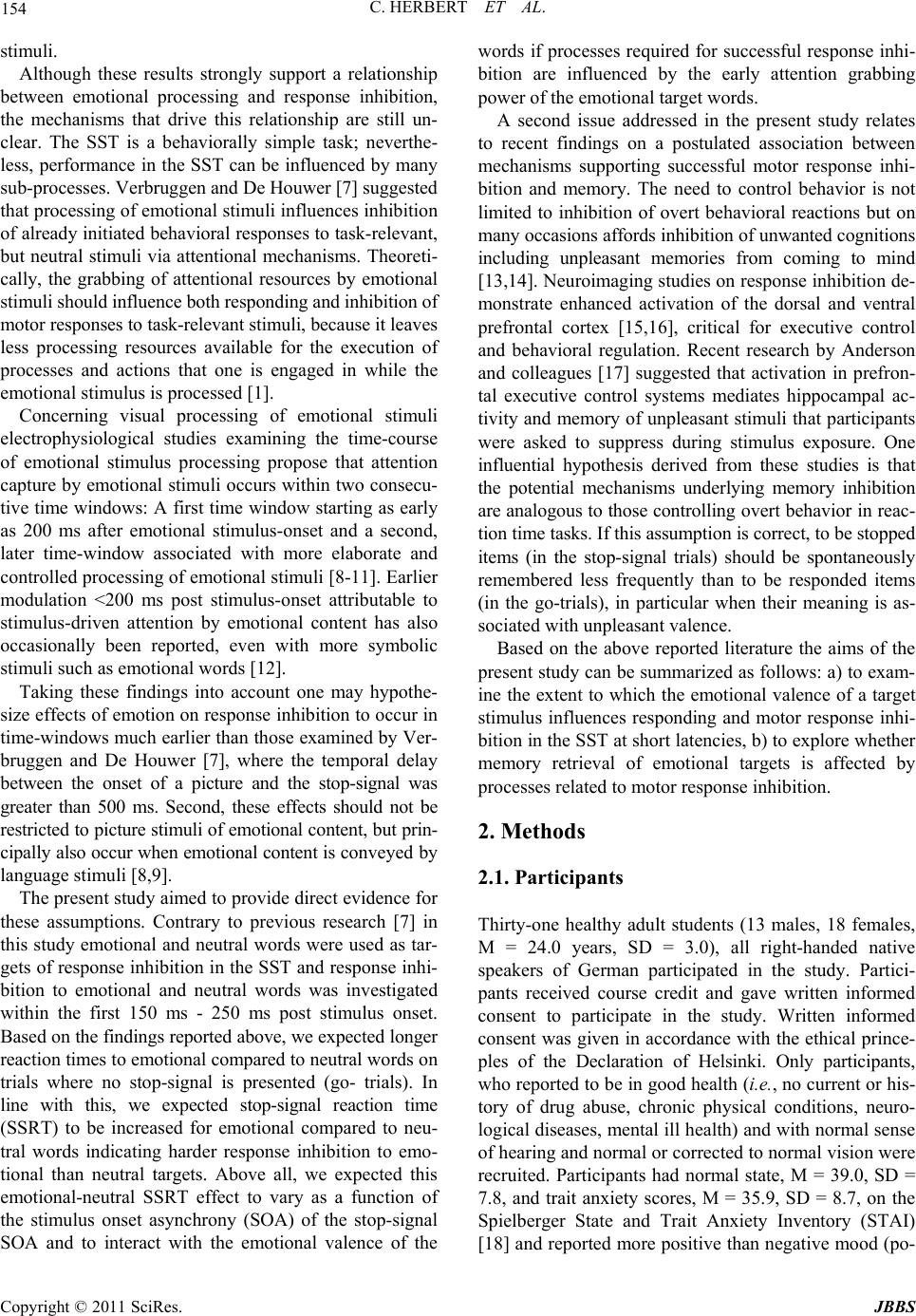 C. HERBERT ET AL. Copyright © 2011 SciRes. JBBS 154 stimuli. Although these results strongly support a relationship between emotional processing and response inhibition, the mechanisms that drive this relationship are still un- clear. The SST is a behaviorally simple task; neverthe- less, performance in the SST can be influenced by many sub-processes. Verbruggen and De Houwer [7] suggested that processing of emotional stimuli influen ces inhibition of already initiated behavioral responses to task-relevant, but neutral stimuli via attentional mechanisms. Theoreti- cally, the grabbing of attentional resources by emotional stimuli should influence both responding and inhibition of motor responses to task-relevan t stimuli, b ecau se it l e aves less processing resources available for the execution of processes and actions that one is engaged in while the emotional stimulus is processed [1]. Concerning visual processing of emotional stimuli electrophysiological studies examining the time-course of emotional stimulus processing propose that attention capture by emotional stimuli occurs within two consecu- tive time windows: A first time window starting as early as 200 ms after emotional stimulus-onset and a second, later time-window associated with more elaborate and controlled processing of emotional stimuli [8-11]. Earlier modulation <200 ms post stimulus-onset attributable to stimulus-driven attention by emotional content has also occasionally been reported, even with more symbolic stimuli such as emotional words [12]. Taking these findings into account one may hypothe- size effects of emotion on response inhibition to occur in time-windows much earlier than those examined by Ver- bruggen and De Houwer [7], where the temporal delay between the onset of a picture and the stop-signal was greater than 500 ms. Second, these effects should not be restricted to picture stimuli of emotional content, but prin- cipally also occur when emotional content is conv eye d b y language stimuli [8,9]. The present study aimed to provide direct evidence for these assumptions. Contrary to previous research [7] in this study emotional and neutral words were used as tar- gets of response inhibition in the SST and response inhi- bition to emotional and neutral words was investigated within the first 150 ms - 250 ms post stimulus onset. Based on the findings reported above, we expected longer reaction times to emotional co mpared to neu tral wo rd s o n trials where no stop-signal is presented (go- trials). In line with this, we expected stop-signal reaction time (SSRT) to be increased for emotional compared to neu- tral words indicating harder response inhibition to emo- tional than neutral targets. Above all, we expected this emotional-neutral SSRT effect to vary as a function of the stimulus onset asynchrony (SOA) of the stop-signal SOA and to interact with the emotional valence of the words if processes required for successful response inhi- bition are influenced by the early attention grabbing power of the emotional target words. A second issue addressed in the present study relates to recent findings on a postulated association between mechanisms supporting successful motor response inhi- bition and memory. The need to control behavior is not limited to inhibition of overt behavioral reactions but on many occasions affords inhibition of unwanted cognitions including unpleasant memories from coming to mind [13,14]. Neuroimaging studies on response inhibition de- monstrate enhanced activation of the dorsal and ventral prefrontal cortex [15,16], critical for executive control and behavioral regulation. Recent research by Anderson and colleagues [17] suggested that activation in prefron- tal executive control systems mediates hippocampal ac- tivity and memory of unpleasant stimuli that participants were asked to suppress during stimulus exposure. One influential hypothesis derived from these studies is that the potential mechanisms underlying memory inhibition are analogous to those controlling overt behavior in reac- tion time tasks. If this assumption is co rrect, to be stopped items (in the stop-signal trials) should be spontaneously remembered less frequently than to be responded items (in the go-trials), in particular when their meaning is as- sociated with unpleasant valence. Based on the above reported literature the aims of the present study can be summarized as follows: a) to exam- ine the extent to which the emotional valence of a target stimulus influences responding and motor response inhi- bition in the SST at short latencies, b) to explore whether memory retrieval of emotional targets is affected by processes related to motor response inhibition. 2. Methods 2.1. Participants Thirty-one healthy adult students (13 males, 18 females, M = 24.0 years, SD = 3.0), all right-handed native speakers of German participated in the study. Partici- pants received course credit and gave written informed consent to participate in the study. Written informed consent was given in accordance with the ethical prince- ples of the Declaration of Helsinki. Only participants, who reported to be in good health (i.e., no current or his- tory of drug abuse, chronic physical conditions, neuro- logical diseases, mental ill health) and with normal sense of hearing and normal or corrected to normal vision were recruited. Participants had normal state, M = 39.0, SD = 7.8, and trait anxiety scores, M = 35.9, SD = 8.7, on the Spielberger State and Trait Anxiety Inventory (STAI) [18] and reported more positive than negative mood (po- 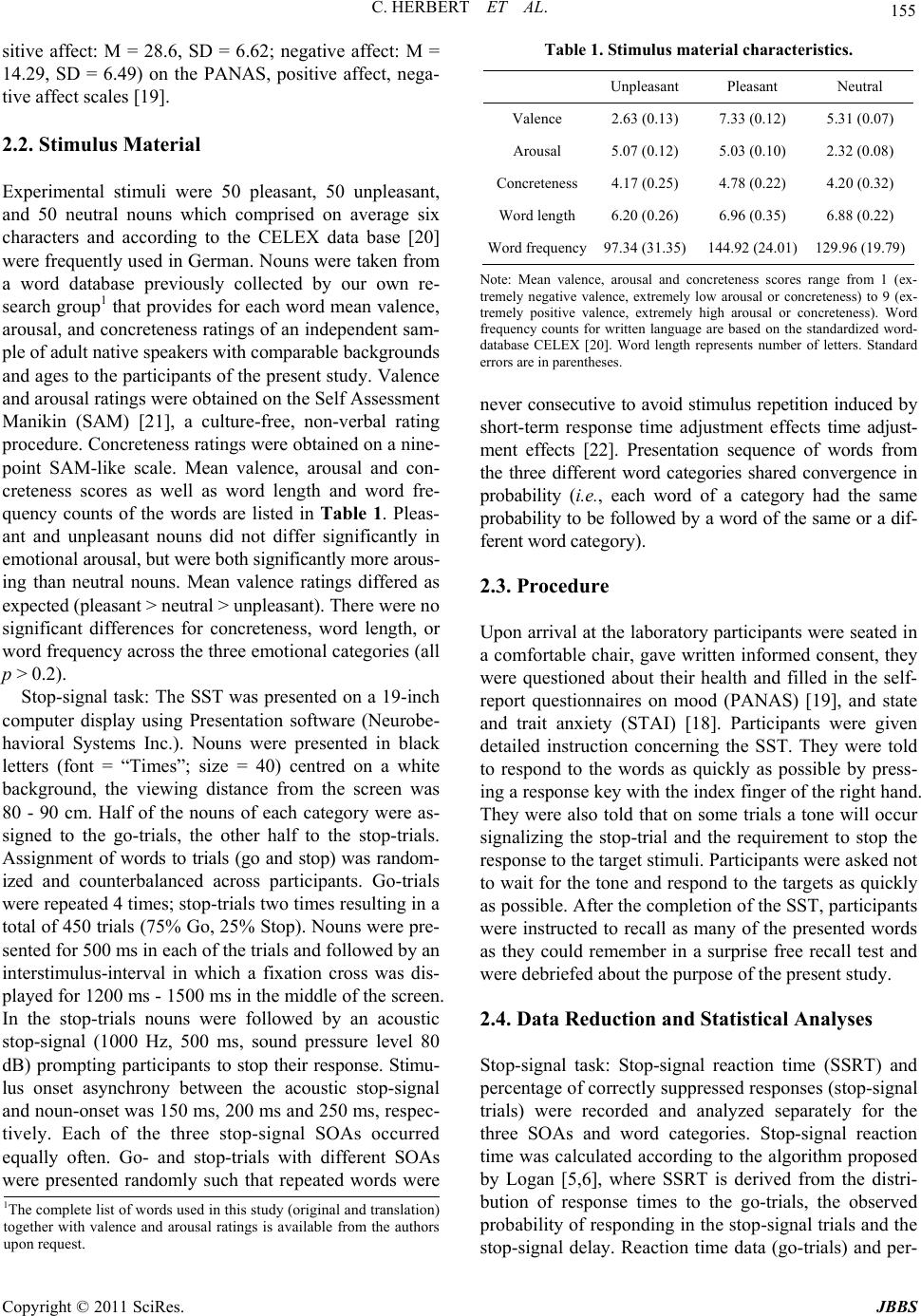 C. HERBERT ET AL. Copyright © 2011 SciRes. JBBS 155 sitive affect: M = 28.6, SD = 6.62; negative affect: M = 14.29, SD = 6.49) on the PANAS, positive affect, nega- tive affect scales [19]. 2.2. Stimulus Material Experimental stimuli were 50 pleasant, 50 unpleasant, and 50 neutral nouns which comprised on average six characters and according to the CELEX data base [20] were frequently used in German. Nouns were taken from a word database previously collected by our own re- search group1 that provides for each word mean valence, arousal, and concreteness ratings of an independent sam- ple of adult native speakers with comparable backgrounds and ages to the participants of the presen t study. Valence and arousal ratings were obtained on the Self Assessment Manikin (SAM) [21], a culture-free, non-verbal rating procedure. Concreteness ratings were obtained on a nine- point SAM-like scale. Mean valence, arousal and con- creteness scores as well as word length and word fre- quency counts of the words are listed in Table 1. Pleas- ant and unpleasant nouns did not differ significantly in emotional arousal, but were both significantly more arous- ing than neutral nouns. Mean valence ratings differed as expected (pleasant > neutral > unpleasant). There were no significant differences for concreteness, word length, or word frequency across the three emotional categories (all p > 0.2). Stop-signal task: The SST was presented on a 19-inch computer display using Presentation software (Neurobe- havioral Systems Inc.). Nouns were presented in black letters (font = “Times”; size = 40) centred on a white background, the viewing distance from the screen was 80 - 90 cm. Half of the nouns of each category were as- signed to the go-trials, the other half to the stop-trials. Assignment of words to trials (go and stop) was random- ized and counterbalanced across participants. Go-trials were repeated 4 times; stop-trials two times resulting in a total of 450 trials (75% Go, 25% Stop). Nouns were pre- sented for 500 ms in each of the trials and followed by an interstimulus-interval in which a fixation cross was dis- played for 1200 ms - 1500 ms in the middle of the screen. In the stop-trials nouns were followed by an acoustic stop-signal (1000 Hz, 500 ms, sound pressure level 80 dB) promptin g participants to stop their response. Stimu- lus onset asynchrony between the acoustic stop-signal and noun-onset was 150 ms, 200 ms and 250 ms, respec- tively. Each of the three stop-signal SOAs occurred equally often. Go- and stop-trials with different SOAs were presented randomly such that repeated words were Table 1. Stimulus material characteristics. Unpleasant Pleasant Neutral Valence 2.63 (0.13) 7.33 (0.12) 5.31 (0.07) Arousal 5.07 (0.12) 5.03 (0.10) 2.32 (0.08) Concreteness4.17 (0.25) 4.78 (0.22) 4.20 (0.32) Word length 6.20 (0.26) 6.96 (0.35) 6.88 (0.22) Word frequency97.34 (31.35)144.92 (24.01) 129.96 (19.79) Note: Mean valence, arousal and concreteness scores range from 1 (ex- tremely negative valence, extremely low arousal or concreteness) to 9 (ex- tremely positive valence, extremely high arousal or concreteness). Word frequency counts for written language are based on the standardized word- database CELEX [20]. Word length represents number of letters. Standard errors are in parentheses. nev er consecutive to avoid stimulus repetition induced by short-term response time adjustment effects time adjust- ment effects [22]. Presentation sequence of words from the three different word categories shared convergence in probability (i.e., each word of a category had the same probabilit y to be followed by a word of th e same or a dif- ferent word category). 2.3. Procedure Upon arrival at the laboratory participants were seated in a comfortable chair, gave written informed consent, they were questioned about their health and filled in the self- report questionnaires on mood (PANAS) [19], and state and trait anxiety (STAI) [18]. Participants were given detailed instruction concerning the SST. They were told to respond to the words as quickly as possible by press- ing a response key with the ind ex fing er of the right hand. They were also told that on some trials a tone will occur signalizing the stop-trial and the requirement to stop the response to the target stimuli. Participants were asked not to wait for the tone and respond to the targets as quickly as possible. After the completio n of the SST, particip ants were instructed to recall as many of the presented words as they could remember in a surprise free recall test and were debriefed about the purpose of the present study. 2.4. Data Reduction and Statistical Analyses Stop-signal task: Stop-signal reaction time (SSRT) and percentage of correctly suppressed responses (stop-signal trials) were recorded and analyzed separately for the three SOAs and word categories. Stop-signal reaction time was calculated according to the algorithm proposed by Logan [5,6], where SSRT is derived from the distri- bution of response times to the go-trials, the observed probability of responding in the stop-signal trials and the stop-signal delay. Reaction time data (go-trials) and per- 1The complete list of words used in this study (original and translation) together with valence and arousal ratings is available from the authors upon request. 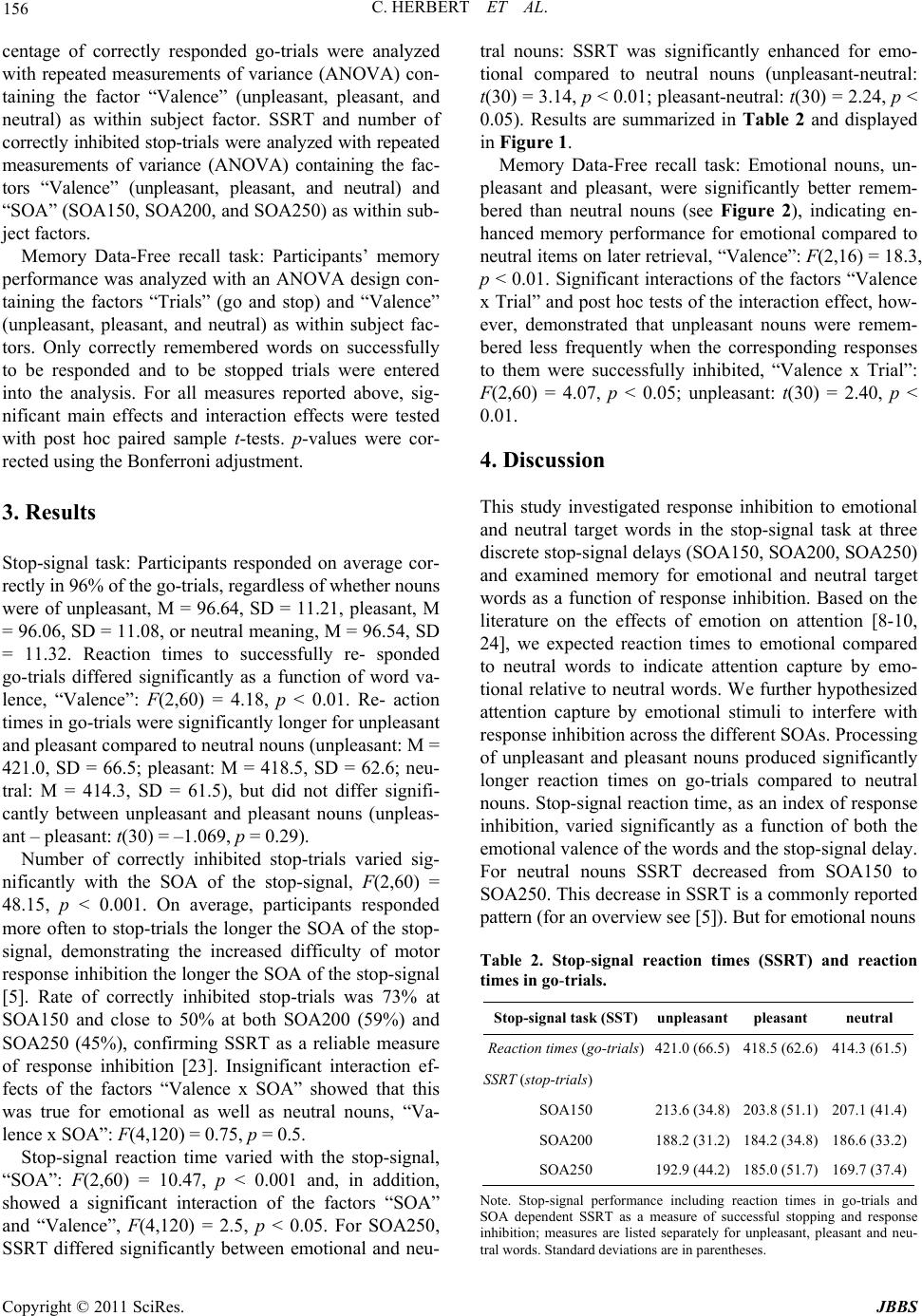 C. HERBERT ET AL. Copyright © 2011 SciRes. JBBS 156 centage of correctly responded go-trials were analyzed with repeated measurements of variance (ANOVA) con- taining the factor “Valence” (unpleasant, pleasant, and neutral) as within subject factor. SSRT and number of correctly inhibited stop-trials were analyzed with repeated measurements of variance (ANOVA) containing the fac- tors “Valence” (unpleasant, pleasant, and neutral) and “SOA” (SOA150, SOA20 0, and SOA250) as w ithin sub- ject factors. Memory Data-Free recall task: Participants’ memory performance was analyzed with an ANOVA design con- taining the factors “Trials” (go and stop) and “Valence” (unpleasant, pleasant, and neutral) as within subject fac- tors. Only correctly remembered words on successfully to be responded and to be stopped trials were entered into the analysis. For all measures reported above, sig- nificant main effects and interaction effects were tested with post hoc paired sample t-tests. p-values were cor- rected using the Bonferroni adjustment. 3. Results Stop-signal task: Participants responded on average cor- rectly in 96% of the go-trials, regardless of whether nouns were of unpleasant, M = 96.64, SD = 11.21, pleasant, M = 96.06, SD = 11.08, or neutral meaning, M = 96.54, SD = 11.32. Reaction times to successfully re- sponded go-trials differed significantly as a function of word va- lence, “Valence”: F(2,60) = 4.18, p < 0.01. Re- action times in go-trials were significantly long er for unp leasan t and pleasant compared to neutral nouns (unpleasant: M = 421.0, SD = 66.5; pleasant: M = 418.5, SD = 62.6; neu- tral: M = 414.3, SD = 61.5), but did not differ signifi- cantly between unpleasant and pleasant nouns (unpleas- ant – pleasant: t(30) = –1.069, p = 0.29). Number of correctly inhibited stop-trials varied sig- nificantly with the SOA of the stop-signal, F(2,60) = 48.15, p < 0.001. On average, participants responded more often to stop-trials the longer the SOA of the stop- signal, demonstrating the increased difficulty of motor response inhibition the longer the SOA of the stop-signal [5]. Rate of correctly inhibited stop-trials was 73% at SOA150 and close to 50% at both SOA200 (59%) and SOA250 (45%), confirming SSRT as a reliable measure of response inhibition [23]. Insignificant interaction ef- fects of the factors “Valence x SOA” showed that this was true for emotional as well as neutral nouns, “Va- lence x SOA”: F(4,120) = 0.75, p = 0.5. Stop-signal reaction time varied with the stop-signal, “SOA”: F(2,60) = 10.47, p < 0.001 and, in addition, showed a significant interaction of the factors “SOA” and “Valence”, F(4,120) = 2.5, p < 0.05. For SOA250, SSRT differed significantly between emotional and neu- tral nouns: SSRT was significantly enhanced for emo- tional compared to neutral nouns (unpleasant-neutral: t(30) = 3.14, p < 0.01; pleasant-neutral: t(30) = 2.24, p < 0.05). Results are summarized in Table 2 and displayed in Figure 1. Memory Data-Free recall task: Emotional nouns, un- pleasant and pleasant, were significantly better remem- bered than neutral nouns (see Figure 2), indicating en- hanced memory performance for emotional compared to neutral items on later retrieval, “Valence”: F(2,16) = 18.3, p < 0.01. Significant interactions of the factors “Valence x Trial” and post hoc tests of the interaction effect, how- ever, demonstrated that unpleasant nouns were remem- bered less frequently when the corresponding responses to them were successfully inhibited, “Valence x Trial”: F(2,60) = 4.07, p < 0.05; unpleasant: t(30) = 2.40, p < 0.01. 4. Discussion This study investigated response inhibition to emotional and neutral target words in the stop-signal task at three discrete stop-signal delays (SOA150, SOA200, SOA250) and examined memory for emotional and neutral target words as a function of response inhibition. Based on the literature on the effects of emotion on attention [8-10, 24], we expected reaction times to emotional compared to neutral words to indicate attention capture by emo- tional relative to neutral words. We further hypothesized attention capture by emotional stimuli to interfere with response inhibition across the different SOAs. Processing of unpleasant and pleasant nouns produced significantly longer reaction times on go-trials compared to neutral nouns. Stop-signal reaction time, as an index of response inhibition, varied significantly as a function of both the emotional valence of the words and the stop-signal delay. For neutral nouns SSRT decreased from SOA150 to SOA250. This decrea se in SSRT is a comm only rep orted pattern (for an over vie w see [ 5] ). But fo r em ot i onal nouns Table 2. Stop-signal reaction times (SSRT) and reaction times in go-trials. Stop-signal task (SST)unpleasant pleasant neutral Reaction times (go-trials)421.0 (66.5) 418.5 (62.6) 414.3 (61.5) SSRT (stop-trials) SOA150 213.6 (34.8) 203.8 (51.1) 207.1 (41.4) SOA200 188.2 (31.2) 184.2 (34.8) 186.6 (33.2) SOA250 192.9 (44.2) 185.0 (51.7) 169.7 (37.4) Note. Stop-signal performance including reaction times in go-trials and SOA dependent SSRT as a measure of successful stopping and response inhibition; measures are listed separately for unpleasant, pleasant and neu- tral words. St andard deviations are i n p arentheses. 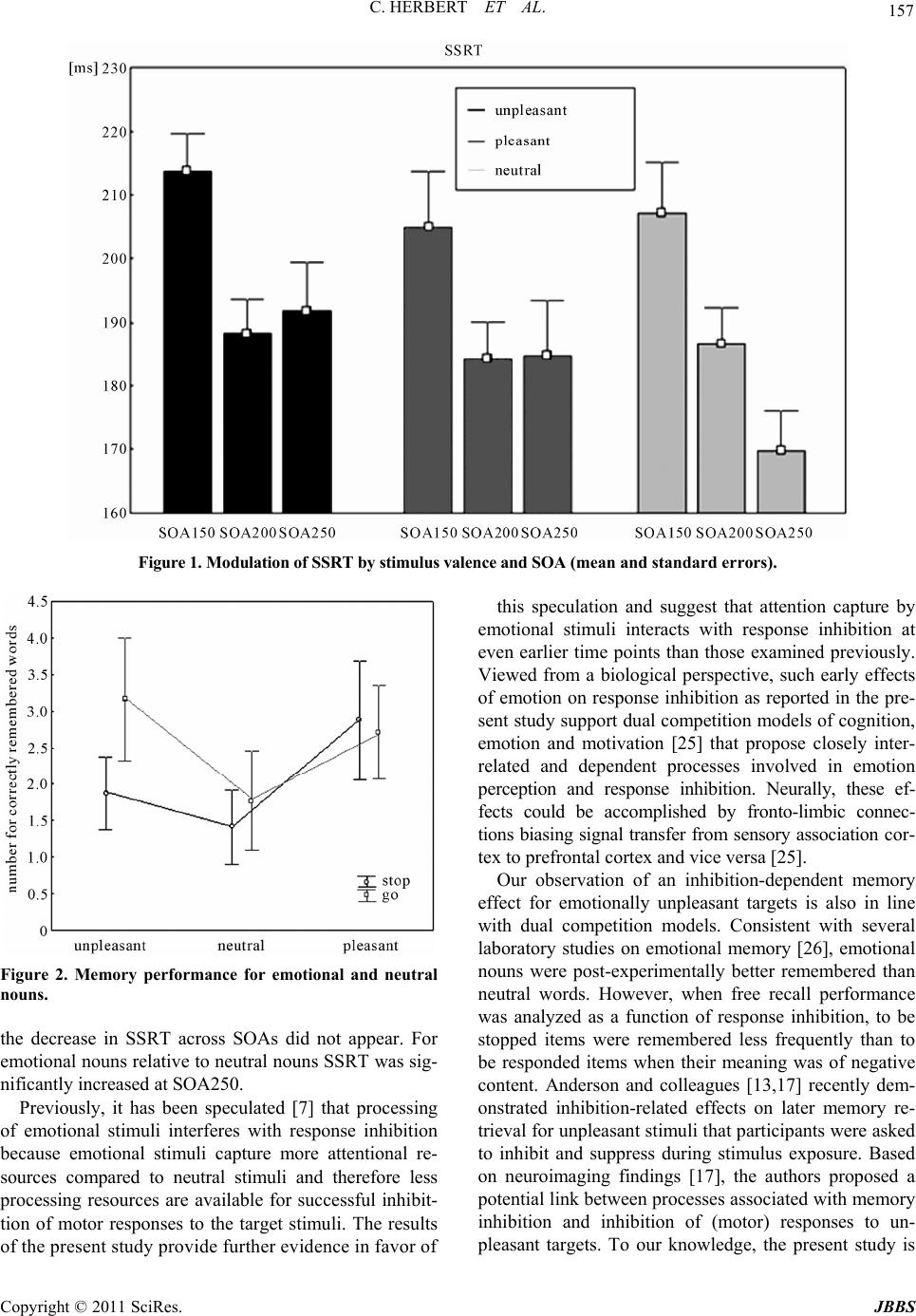 C. HERBERT ET AL. Copyright © 2011 SciRes. JBBS 157 Figur e 1. M o dul a tio n of S S RT b y s tim ulus valence a nd SOA (mean and standard errors). Figure 2. Memory performance for emotional and neutral nouns. the decrease in SSRT across SOAs did not appear. For emotional nouns relative to neutral nouns SSRT was sig- nificantly increased at SOA250. Previously, it has been speculated [7] that processing of emotional stimuli interferes with response inhibition because emotional stimuli capture more attentional re- sources compared to neutral stimuli and therefore less processing resources are available for successful inhibit- tion of motor responses to the target stimuli. The results of the present study provide further evidence in favor of this speculation and suggest that attention capture by emotional stimuli interacts with response inhibition at even earlier time points than those examined previously. Viewed from a biological perspective, such early effects of emotion on response inhibition as reported in the pre- sent study support du al competition models of cog nition, emotion and motivation [25] that propose closely inter- related and dependent processes involved in emotion perception and response inhibition. Neurally, these ef- fects could be accomplished by fronto-limbic connec- tions biasing signal transfer from sensory association cor- tex to prefrontal cortex and vice versa [25]. Our observation of an inhibition-dependent memory effect for emotionally unpleasant targets is also in line with dual competition models. Consistent with several laboratory studies on emotional memory [26], emotional nouns were post-experimentally better remembered than neutral words. However, when free recall performance was analyzed as a function of response inhibition, to be stopped items were remembered less frequently than to be responded items when their meaning was of negative content. Anderson and colleagues [13,17] recently dem- onstrated inhibition-related effects on later memory re- trieval for unpleasant stimuli th at participants were asked to inhibit and suppress during stimulus exposure. Based on neuroimaging findings [17], the authors proposed a potential link between processe s associated with memory inhibition and inhibition of (motor) responses to un- pleasant targets. To our knowledge, the present study is  C. HERBERT ET AL. Copyright © 2011 SciRes. JBBS 158 the first to examine this hypothesis directly by using a motor response inhibition task and both emotional (un- pleasant and pleasant) and neutral stimuli as targets of response inhibition. Regarding unpleasant words, our findings support the assumption of a relationship between memory and inhibitory processes related to motor re- sponse inhibition [13,14,17]. Interestingly, stopping had no influence on recall of pleasant items. This also extends previous research, as this study, contrary to the past memory inhibition studies cited above, made use of stim- uli of unpleasant as well as pleasant and neutral valen ce. Although the reasons for the not impaired memory re- trieval of positive target stimuli requires future research, the finding fits n icely with everyday life experience: that attempts not to respond to pleasurable or rewarding cues (e.g., palatable food when on diet, expensive clothes when short of money, etc.) does not necessarily weaken the representation of these cues in memory. In summary, our results provided evidence that proc- essing and response inhibition of emotional targets in- teract. These interaction effects appear to arise even at very short latencies of 250 ms after stimulus onset, i.e., in a time-window, where according to the previous lit- era- ture early attention capture by emotional stimuli is ex- pected to be most pronounced. In addition, our results support a relationship between emotion-modulated motor response inhibition and emotional memory. Future stud- ies may offer further insight into the interplay between the mechanisms supporting and attenuating response and memory inhibition in emotion-laden contexts. Applica- tion of this experimental approach to clinical samples (e.g., drug addiction, eating disorder, or attention deficit hyperactivity disorder) might be especially interesting to this end [27]. 5. Acknowledgements This research was supported by the German Research Foundati on (DFG). 6. References [1] P. J. Lang, M. M. Bradley and B. N. Cuthbert, “Moti- vated Attention: Affect, Activation, and Action,” In: P. J. Lang, R. F. Simons and M. Balaban, Eds., Attention and Emotion: Sensory and Motivational Processes, Erlbaum, Mahwah, 1997, pp. 97-135. [2] J. DeHouwer and H. Tibboel, “Stop What You Are Not Doing! Emotional Pictures Interfere with the Task Not to Respond,” Psychonomic Bulletin & Review, Vol. 17, No. 5, 2010, pp. 699-703. doi:10.3758/PBR.17.5.699 [3] M. Goldstein, G. Brendel, O. Tuescher, H. Pan, J. Epstein, et al., “Neural Substrates of the Interaction of Emotional Stimulus Processing and Motor Inhibitory Control: An Emotional Linguistic Go/No-Go fMRI Study,” Neuroi- mage, Vol. 36, No. 3 2007, pp. 1026-1040. doi:10.1016/j.neuroimage.2007.01.056 [4] K. P. Schulz, J. Fan, O. Magidina, D. J. Ma rks, B. Hahn, et al., “Does the Emotional Go/No-Go Task Really Measure Behavioral Inhibition? Convergence with Measures on a Non-Emotional Analog,” Archives of Clinical Neuropsychology, Vol. 22, No. 2, 2007, pp. 151- 160. doi:10.1016/j.acn.2006.12.001 [5] G. D. Logan, “On the Ability to Inhibit Thought and Ac- tion: A User’s Guide to the Stop-Signal Paradigm,” In: D. Dagenbach and T. H. Carr, Eds., Inhibitory Processes in Attention, Memory, and Language, Academic Press, San Diego, 1994, pp. 184-239. [6] G. D. Logan and W. B. Cowan, “On the Ability to Inhibit Thought and Action: A Theory of an Act of Control,” Psychological Review, Vol. 91, No. 3, pp. 295-327. doi:10.1037/0033-295X.91.3.295 [7] F. Verbruggen and J. De Houwer, “Do Emotional Stimuli Interfere with Response Inhibition? Evidence from the Stop Signal Paradigm,” Cognition & Emotion, Vol. 21, No. 2, 2007, pp. 391-403. doi:10.1080/02699930600625081 [8] C. Herbert, M. Junghofer and J. Kissler, “Event Related Potentials to Emotional Adjectives during Reading,” Psy- chophysiology, Vol. 45, No. 3, 2008, 487-498. doi:10.1111/j.1469-8986.2007.00638.x [9] J. Kissler, C. Herbert, P. Peyk and M. Junghofer, “Buzz- words: Early Cortical Responses to Emotional Words during Reading,” Psychological Science, Vol. 18, No. 6, 2007, pp. 475-480. doi:10.1111/j.1467-9280.2007.01924.x [10] H. T. Schupp, T. Flaisch, J. Stockburger and M. Jung- hofer, “Emotion and Attention: Event-Related Brain Po- tential Studies,” Progress in Brain Research, Vol. 156, 2006, pp. 31-51. doi:10.1016/S0079-6123(06)56002-9 [11] J. Kissler, R. Assadollahi and C. Herbert, “Emotional and Semantic Networks in Visual Word Processing: Insights from ERP Studies,” Progress in Brain Research, Vol. 156, 2006, pp. 147-183. doi:10.1016/S0079-6123(06)56008-X [12] M. J. Hofmann, L. Kuchinke, S. Tamm, M. L. Vo and A. M. Jacobs, “Affective Processing within 1/10th of a Sec- ond: High Arousal Is Necessary for Early Facilitative Processing of Negative but not Positive Words,” Cogni- tive Affective and Behavioral Neuroscience, Vol. 9, No. 4, 2009, pp. 389-397. doi:10.3758/9.4.389 [13] M. C. Anderson and C. Green, “Suppressing Unwanted Memories by Executive Control,” Nature, Vol. 410, 2001, pp. 366-369. doi:10.1038/35066572 [14] M. C. Anderson and B. C. Levy, “Suppressing Unwanted Memories,” Current Directions in Psychological Science, Vol. 18, No. 4, 2009, pp. 189-194. doi:10.1111/j.1467-8721.2009.01634.x [15] S. Konishi, K. Nakajima, I. Uchida, H. Kikyo, M. Kameyama, et al., “Common Inhibitory Mechanisms in Human Inferior Prefrontal Cortex Revealed by Functional MRI,” Brain, Vol. 122, No. 5, 1999, pp. 981-991. 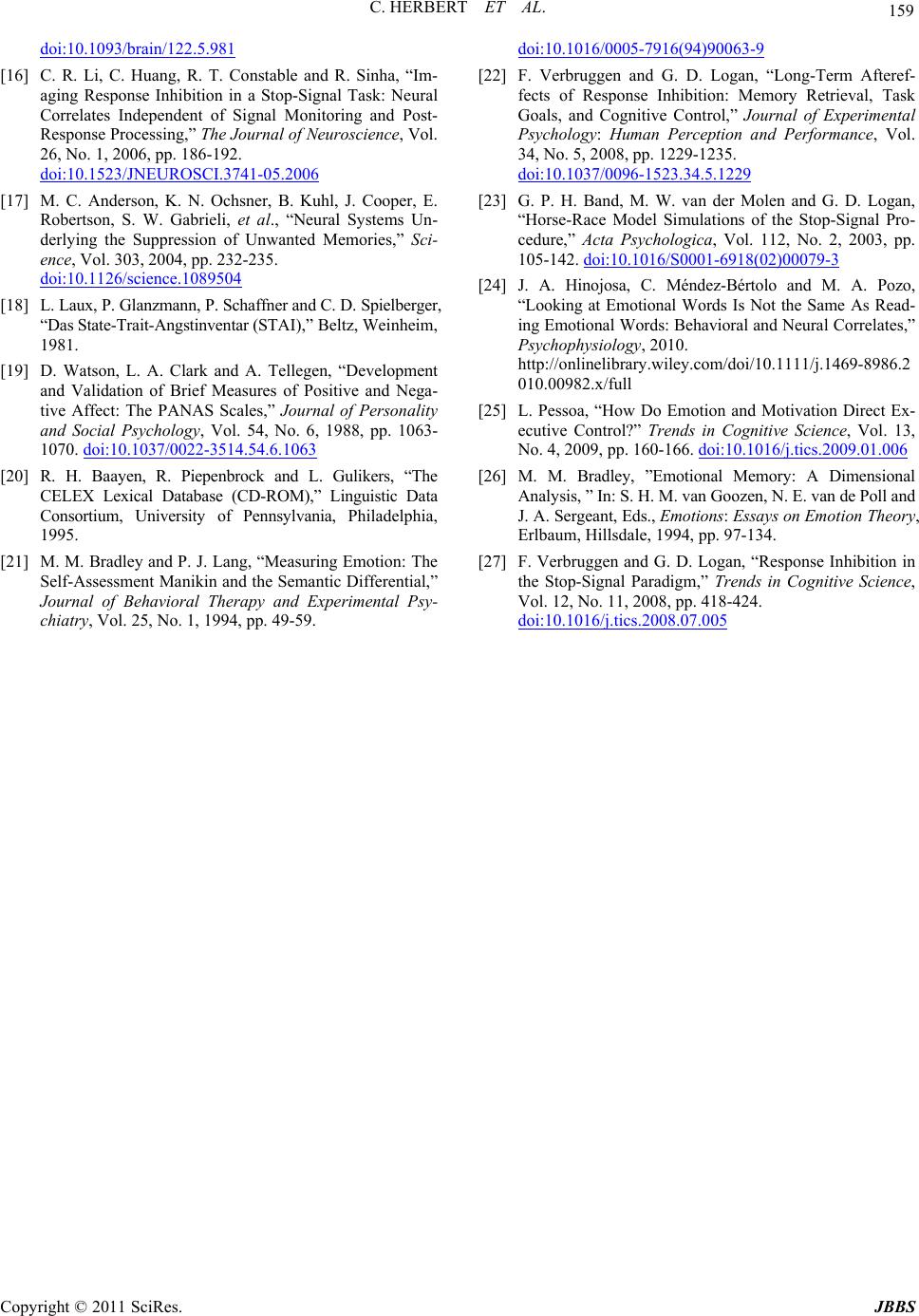 C. HERBERT ET AL. Copyright © 2011 SciRes. JBBS 159 doi:10.1093/brain/122.5.981 [16] C. R. Li, C. Huang, R. T. Constable and R. Sinha, “Im- aging Response Inhibition in a Stop-Signal Task: Neural Correlates Independent of Signal Monitoring and Post- Response Processing,” The Journal of Neuroscience, Vol. 26, No. 1, 2006, pp. 186-192. doi:10.1523/JNEUROSCI.3741-05.2006 [17] M. C. Anderson, K. N. Ochsner, B. Kuhl, J. Cooper, E. Robertson, S. W. Gabrieli, et al., “Neural Systems Un- derlying the Suppression of Unwanted Memories,” Sci- ence, Vol. 303, 2004, pp. 232-235. doi:10.1126/science.1089504 [18] L. Laux, P. Glanzmann, P. Schaffner and C. D. Sp ielberger, “Das State-Trait-Angstinventar (STAI),” Beltz, Weinheim, 1981. [19] D. Watson, L. A. Clark and A. Tellegen, “Development and Validation of Brief Measures of Positive and Nega- tive Affect: The PANAS Scales,” Journal of Personality and Social Psychology, Vol. 54, No. 6, 1988, pp. 1063- 1070. doi:10.1037/0022-3514.54.6.1063 [20] R. H. Baayen, R. Piepenbrock and L. Gulikers, “The CELEX Lexical Database (CD-ROM),” Linguistic Data Consortium, University of Pennsylvania, Philadelphia, 1995. [21] M. M. Bradley and P. J. Lang, “Measuring Emotion: The Self-Assessment Manikin and the Semantic Differential,” Journal of Behavioral Therapy and Experimental Psy- chiatry, Vol. 25, No. 1, 1994, pp. 49-59. doi:10.1016/0005-7916(94)90063-9 [22] F. Verbruggen and G. D. Logan, “Long-Term Afteref- fects of Response Inhibition: Memory Retrieval, Task Goals, and Cognitive Control,” Journal of Experimental Psychology: Human Perception and Performance, Vol. 34, No. 5, 2008, pp. 1229-1235. doi:10.1037/0096-1523.34.5.1229 [23] G. P. H. Band, M. W. van der Molen and G. D. Logan, “Horse-Race Model Simulations of the Stop-Signal Pro- cedure,” Acta Psychologica, Vol. 112, No. 2, 2003, pp. 105-142. doi:10.1016/S0001-6918(02)00079-3 [24] J. A. Hinojosa, C. Méndez-Bértolo and M. A. Pozo, “Looking at Emotional Words Is Not the Same As Read- ing Emotional Words: Behavioral and Neural Co rrelat es,” Psychophysiology, 2010. http://onlinelibrary.wiley.com/doi/10.1111/j.1469-8986.2 010.00982.x/full [25] L. Pessoa, “How Do Emotion and Motivation Direct Ex- ecutive Control?” Trends in Cognitive Science, Vol. 13, No. 4, 2009, pp. 160-166. doi:10.1016/j.tics.2009.01.006 [26] M. M. Bradley, ”Emotional Memory: A Dimensional Analysis, ” In: S. H. M. van Goozen, N. E. van de Poll and J. A. Sergeant, Eds., Emotions: Essays on Emotion Theory, Erlbaum, Hillsdale, 1994, pp. 97-134. [27] F. Verbruggen and G. D. Logan, “Response Inhibition in the Stop-Signal Paradigm,” Trends in Cognitive Science, Vol. 12, No. 11, 2008, pp. 418-424. doi:10.1016/j.tics.2008.07.005 |

